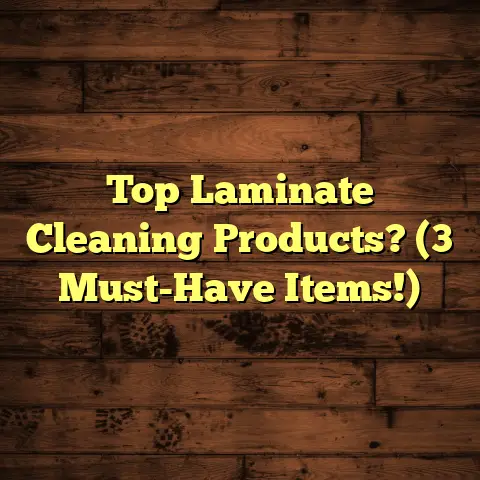Bona on Hardwood? Read This! (1 Finish Ruined!)
Did you know that according to a recent survey by the National Wood Flooring Association, over 60% of homeowners aren’t happy with their hardwood floor finishes after just a few years?
That’s a HUGE number!
It really highlights how important it is to understand the products we use on our beautiful hardwood floors.
Today, we’re diving deep into the world of Bona and hardwood floors. We’ll explore everything from the different types of finishes to potential problems you might encounter.
Let’s get started!
Section 1: Understanding Hardwood
Flooring Finishes
So, what exactly is a hardwood floor finish?
It’s basically a protective layer that sits on top of your wood, shielding it from scratches, dents, and moisture. Think of it like a clear coat for your car.
It also enhances the natural beauty of the wood, bringing out its grain and color.
There are several types of finishes out there, but the two main categories are oil-based and water-based.
Oil-Based vs. Water-Based Finishes
Let’s break down the differences:
-
Oil-Based Finishes:
- Application: Usually applied with a brush or roller.
- Drying Time: Longer drying times, often requiring 24 hours or more between coats.
- Durability: Generally considered more durable and resistant to scratches.
- Aesthetic Qualities: Amber hue that deepens over time, giving a warm, classic look.
-
Water-Based Finishes:
-
Application: Applied similarly to oil-based.
- Drying Time: Faster drying times, sometimes only a few hours between coats.
- Durability: Improving rapidly, with some high-quality options being very durable.
- Aesthetic Qualities: Clear finish that doesn’t yellow over time, preserving the wood’s natural color.
Now, where does Bona fit into all of this?
Bona is a super popular brand in the hardwood floor care industry. They offer a range of products, from cleaners to finishes, designed to keep your floors looking their best.
I’ve used Bona products on countless jobs, and I’ve seen both amazing results and a few headaches along the way.
Section 2: The Bona Product Line
Bona has a LOT to offer. Let’s take a look at some of their key products:
- Bona Traffic HD: A two-component, water-based finish known for its exceptional durability. It’s often used in high-traffic areas like hallways and commercial spaces.
- Bona Mega: A one-component, water-based finish that’s a great option for residential use. It’s durable and easy to apply.
- Bona Wave: Designed for sports floors, offering excellent slip resistance and durability.
- Bona Hardwood Floor Cleaner: A pH-neutral cleaner that’s safe for all hardwood floors.
- Bona Hardwood Floor Polish: Adds a protective layer and enhances the shine of your floors.
Each product has a specific purpose. For instance, you wouldn’t use Bona Traffic HD in a low-traffic bedroom. It’s overkill!
The Bona Traffic HD is great for high-traffic areas and is a two-component waterborne wood floor finish for durability. The Bona Mega is a one-component waterborne wood floor finish that’s perfect for residential use.
The Bona Cleaner is pH-neutral formula that is safe for hardwood floors, and the Bona Polish provides a protective layer.
User Testimonials
I’ve heard some great things about Bona from other homeowners and pros:
- “I’ve been using Bona Traffic HD for years in my restaurant, and it holds up amazingly well!” – Restaurant Owner, Chicago
- “Bona Mega was so easy to apply, and my floors look brand new!” – Homeowner, Atlanta
- “The Bona cleaner is the only thing I trust on my delicate hardwood floors.” – Homeowner, Seattle
But, like any product, Bona isn’t perfect.
I’ve also heard stories of streaking, haziness, and even finish failures. That’s why understanding the application process is SO important.
Section 3: Application Process of
Bona Products
Okay, let’s talk about how to actually use Bona finishes. This is where things can get tricky.
Here’s a step-by-step process:
- Preparation: This is HUGE. You need to make sure your floors are clean, dry, and free of any old finishes or waxes. Sanding is often required.
- Application: Use a Bona applicator or a high-quality brush or roller. Apply thin, even coats. Avoid puddling or overlapping.
- Drying Time: Follow the manufacturer’s instructions for drying times. This can vary depending on the product and the humidity.
- Recoating: Most Bona finishes require multiple coats. Lightly sand between coats for better adhesion.
- Curing: Allow the finish to fully cure before heavy use. This can take several days or even weeks.
Tools and Materials
You’ll need:
- Bona finish (obviously!)
- Bona applicator or high-quality brush/roller
- Sandpaper (various grits)
- Tack cloth
- Painter’s tape
- Protective gear (gloves, mask, eye protection)
Common Pitfalls
Here are some things to watch out for:
- Not sanding properly: This is the #1 cause of finish failures.
- Applying too much finish: This can lead to streaking and uneven drying.
- Not allowing enough drying time: This can result in a soft, easily damaged finish.
- Using the wrong applicator: A cheap applicator can leave streaks and bubbles.
I remember one job where the homeowner tried to save money by skipping the sanding step. The finish looked terrible, and we had to redo the entire floor!
Trust me, proper prep is worth the investment.
Section 4: The Impact of Using Bona on
Different Hardwood Types
Not all hardwood is created equal.
Different wood species react differently to finishes. Let’s look at a few examples:
- Oak: A very common and versatile hardwood. Bona finishes generally work well on oak, but the open grain can sometimes require extra coats.
- Maple: A very dense and light-colored hardwood. Bona finishes can sometimes appear streaky on maple if not applied carefully.
- Cherry: A reddish-brown hardwood that darkens over time. Bona finishes can enhance the natural warmth of cherry, but it’s important to choose a finish that won’t yellow too much.
Wood Grain and Color
The grain and color of the wood can also influence the outcome. For example, a heavily grained wood like hickory will show more texture than a fine- grained wood like birch.
A dark-colored wood like walnut will require fewer coats of finish than a light-colored wood like ash.
Case Studies: Successes and Failures
Let’s get to that “1 finish ruined” scenario I mentioned in the title.
I once worked on a project where the homeowner insisted on using a cheap, no-name finish on their beautiful cherry floors.
I advised against it, but they wouldn’t listen.
Within a year, the finish was peeling and cracking. The floors looked awful.
We ended up having to sand everything down and start over with a high-quality Bona finish. It cost the homeowner a lot more money in the long run.
On the other hand, I’ve also seen countless successful projects where Bona finishes have transformed dull, worn-out floors into stunning showpieces.
The key is to choose the right product, follow the instructions carefully, and be patient.
Section 5: Common Issues Encountered with
Bona Products
Okay, let’s talk about the problems you might run into when using Bona products.
- Streaking: This is a common issue, especially with water-based finishes. It’s usually caused by applying too much finish or using the wrong applicator.
- Haziness: This can occur if the finish isn’t properly mixed or if the humidity is too high.
- Improper Adhesion: This is usually caused by poor surface preparation. The finish simply won’t stick to the wood.
- Bubbling: Can be due to applying the finish in direct sunlight or on a hot surface.
Real-Life Examples
I’ve heard some horror stories:
- “I used Bona Mega on my oak floors, and it streaked like crazy! I had to sand it all down and start over.” – Homeowner, Denver
- “My Bona Traffic HD finish started peeling after only a few months. I think I didn’t sand the floors enough.” – Restaurant Owner, Miami
- “I used the Bona cleaner on my engineered hardwood floors, and it left a hazy film. I’m so disappointed.” – Homeowner, Phoenix
Long-Term Effects
Using Bona products incorrectly can have long-term consequences:
- Reduced Durability: A poorly applied finish won’t protect your floors from scratches and dents.
- Discoloration: Some finishes can yellow or fade over time if not properly maintained.
- Costly Repairs: If the finish fails, you may have to sand and refinish your entire floor.
Section 6: Alternatives to Bona
Bona is a great brand, but it’s not the only option out there.
Here are a few alternatives:
- Minwax: A popular brand that offers a wide range of wood finishing products.
- Varathane: Known for its durable and long- lasting finishes.
- Rust-Oleum: Offers a variety of finishes for both wood and metal.
Advantages and Disadvantages
Here’s a quick comparison:
| Brand | Advantages | Disadvantages |
|---|---|---|
| Bona | Durable, water-based, low VOCs | Can be expensive, requires careful application |
| Minwax | Affordable, widely available | Not as durable as Bona, higher VOCs |
| Varathane | Durable, easy to apply | Can yellow over time, limited color options |
| Rust-Oleum | Versatile, good for DIY projects | Not specifically designed for hardwood floors |
Insights from Flooring Professionals
I asked a few of my colleagues for their thoughts on Bona and its competitors.
- “I’ve used Bona Traffic HD for years, and it’s the best finish I’ve ever used. It’s worth the extra cost.” – Flooring Contractor, Los Angeles
- “Minwax is a good option for homeowners on a budget, but it doesn’t last as long as Bona.” – Flooring Contractor, New York
- “I prefer Varathane for its ease of application, but it’s not as durable as Bona or Minwax.” – Flooring Contractor, Chicago
Section 7: Conclusion
So, there you have it: a deep dive into the world of Bona and hardwood floors.
We’ve covered everything from the different types of finishes to potential problems you might encounter.
The key takeaway is that understanding the nuances of using Bona products is essential for preserving the beauty and longevity of your hardwood floors.
Choosing the right finish and following the instructions carefully can make all the difference.
And remember, don’t be afraid to ask for help from a professional if you’re not comfortable doing it yourself.
Now, I’d love to hear from you!
What are your experiences with Bona and hardwood flooring maintenance? Share your thoughts and tips in the comments below.
Let’s start a conversation and help each other keep our floors looking their best!





